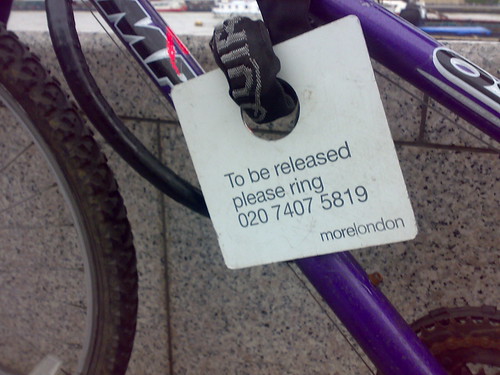Cities are full of public space; between the buildings – most of which are private, some of which are public – is space, most of which is public, some of which is private.
Some of that public space isn’t, really. It looks like it is – and part of the conditions of its existence are that it serves as a limited thoroughfare – but it’s very much a private space that you’re lucky to be allowed on, and which can be policed privately.
Nowhere is that more obvious than More London – a complex directly west of Tower Bridge, where City Hall resides, as does a variety of office buildings. It contains the obvious walking route along the river front; it’s designed as a very public space. But it isn’t at all: it’s private property, with its own rules.
Lock a bike to a lamp-post and this happens:
That lamp-post wasn’t yours to lock it to. This sort of thing both frustrating and confusing: why does this space, which looks like any other space, behave differently? How was one to know it wasn’t, technically, public? If you don’t see the little signs, you wouldn’t know. People walking freely, people eating their lunch in the open spaces: these are much greater signifiers for the urban citizen, and these all seem to fit a representation of “publicness”.
More and more of the city looks like this.
What happened with Tower Bridge on Twitter a few weeks back was a reminder that this is also true online. Twitter isn’t a public space like the domain name system is; it’s a private one, and you’re at the whim of its Terms of Service. I infringed its Terms (just), things got moved around.
So far, so walled-garden. We’ve seen things like this before.
But there’s a slightly larger, and more complex question raised here, and that’s the one I’m much more concerned about.
The frustrations that you see in the real city are coming to the instrumented city, and this highlights an interesting set of problems if you’re designing that instrumented city.
(What follows is not about my bot in specific; it’s about the state of existing terms of service around the web, and what they mean for any form of instrumentation and augmentation).
The idea that an object representing a structure itself in the first person isn’t allowed to describe itself is problematic; the idea that someone with the rights to a trademark has more claim to represent a structure, an edifice, than a stream of information that the structure itself produces is… troubling. (I’m not sure I can find the right word there just yet).
There’s something important about authorship and identity here, and the idea to suggest that the streams of information about a structure come from anywhere other than that structure itself feels backward.
(I would, of course have no problem if the trademark owner wished to produce that stream of information themselves).
The Transamerica Pyramid doesn’t have an account on Flickr so that people can pretend to be it, or pretend to upload photographs in its name. It has an account so that it can be pointed at in other photographs; it has an account so that it can be referenced just like a person. How do you enable something to serve that purpose if it doesn’t have the actual name of the building in question? The account isn’t impersonating the building; it is the building. Those photographs aren’t lying about having the Pyramid in them. (As it stands: the account on Flickr is called “The Pointy Building”, which is both non-infringing, but also a more accurate representation of what most people call the building anyway).
There are obvious issues that the Instrumented City, ultimately, will find ways around. Twitter – a short, written-language service – really isn’t the best format for instrumenting the city in the long run; it’s just what some of us are using for now. So I’m not worried about service-specific issues or any particular terms of service. I’m sure that the city of data will find more detailed, specified delivery formats for its information that building-owners will buy into, although I’d hope there’d still be an emphasis on the human-readability of such information.
For now, though, this is what we have, and these are the issues we have to work around, and they bear thinking about.

